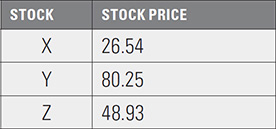| CHAPTER 19 |
Stock Indexes
The three most common methods of constructing a stock index are price-weighting, capitalization-weighting, and equal-weighting.
In a price-weighted index the initial value of the index is equal to the sum of the prices of the individual stocks that make up the index.
price-weighted index value = ΣSi
In a capitalization-weighted index the initial value of the index is equal to the sum of the capitalizations of the individual companies that make up the index. The capitalization of a company is equal to the total value of all outstanding stock in that company.
capitalization-weighted index value = Σ(Si × number of shares outstanding)
In an equal-weighted index, each stock initially accounts for exactly an equal proportion of the index. So the index value is initially equal to the number of stocks which make up the index.
equal-weighted index value = Σ(Si/ Si)
As stock prices change, the contribution of each stock will change by the percent change in each stock’s price.
equal-weighted index value = Σ(Scurrent price / Sprevious price)
Equal-weighted indexes are periodically rebalanced so that each stock again accounts for exactly an equal proportion of the index.
The weighting of a stock in an index is the amount of the index, in percent terms, accounted for by that stock. The index divisor is a number used to set the raw value of an index equal to a target value or reference value:
raw index value / divisor = target value
1. When the XYZ index is initially introduced, it is made up of the following three stocks:

a. What is the value of the index and the weighting of each stock in the index if the index is:
i. price-weighted?

ii. capitalization-weighted?

iii. equal-weighted?

b. Suppose the index is initially set at a value of 250. What is the index divisor if the index is:
i. price-weighted?
ii. capitalization-weighted?
iii. equal-weighted?
c. With the index value still at 250, stock Y splits 2 for 1: every old share of stock Y at a price of 81.70 is replaced with two new shares at a price of 40.85 each. If the index value remains unchanged at 250, what must be the new index divisor if the index is:
i. price-weighted?
ii. capitalization-weighted?
iii. equal-weighted?
d. Following the 2 for 1 split in stock Y, and with the index price still at 250, stock Z is replaced with stock W, with a price of 34.85 and 6000 outstanding shares. What must be the new index divisor if the index is:
i. price-weighted?
ii. capitalization-weighted?
iii. equal-weighted?
e. Assume that the equal-weighted index is still made up of the original three stocks, X, Y, and Z. At some later date, the prices of the stocks are:

i. What is the current value of the equal-weighted index?
ii. If the index is now rebalanced, such that each stock has an equal weighting in the index, what is the new index divisor?
2. When the price of an index component stock changes, then:
percent change in the index = percent change in the stock price × stock weighting in the index
An index is currently trading at 12,599.83. Among the component stocks in the index are stock A and stock B, with the following prices and weightings in the index:

a. If the price of stock A rises 4.00 to 190.50, and all other stocks in the index remain unchanged, what will be the new index price?
b. After rising to 190.50 stock A subsequently falls 12.00 to 178.50. At the same time stock B rises 2.75 to 101.50. What will be the new index price if all other stocks in the index remain unchanged?
c. When stock A rises from 186.50 to 190.50, what must be its new weighting in the index if all other stocks in the index remain unchanged?
3. The LMN index is made up of the following three stocks:

a. A fund manager has $1,000,000 to invest and would like his holdings to exactly replicate the index. How many shares of each stock must he buy?

b. Instead of replicating the index, a fund manager wants to offset a short position equal to $1,000,000 in three-month index futures contracts. How many shares of each stock must he hold if interest rates are 6.00%?

c. Two months later interest rates have fallen to 5.40%. If the fund manager is still holding his short index futures position, how many shares of each stock must he now hold in order to offset his short futures position?

4. An index futures contract with 72 days remaining to expiration is trading at 2,520.37.
a. If interest rates are 5.33% and the expected dividend over the next 72 days is 9.94 index points, what should be the index cash price?
b. If the index cash price is currently 2,509.80 and the expected dividend over the next 72 days is 9.94 index points, what is the implied interest rate?
c. If the index cash price is currently 2,507.94 and interest rates are 3.83%, what is the implied dividend payout in index points over the next 72 days?
